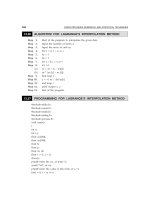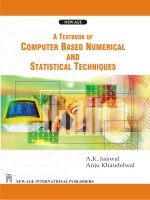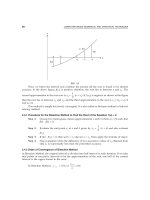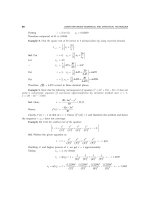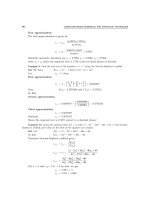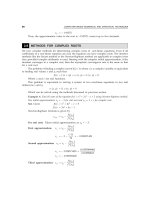A textbook of Computer Based Numerical and Statiscal Techniques part 61 pdf
Bạn đang xem bản rút gọn của tài liệu. Xem và tải ngay bản đầy đủ của tài liệu tại đây (59.16 KB, 10 trang )
586
COMPUTER BASED NUMERICAL AND STATISTICAL TECHNIQUES
for(i = 0; i < n–j; i++)
{
diff[i][j] = diff[i+1][j–1]–diff[i][j–1];
}
}
i = 0;
do
{
i++;
}while(ax[i]<x);
i– –;
p = (x–ax[i])/h;
y1 = p*diff[i–1][1];
y2 = p*(p+1)*diff[i–1][2]/2;
y3 = (p+1)*p*(p–1)*diff[i–2][3]/6;
y4 = (p+1)*p*(p-1)*(p+2)*diff[i–3][4]/24
y = ay[i] + y1 + y2 + y3 + y4;
printf(“when x = %6.4f, y = %6.8f”, x, y);
printf(“press enter to exit”);
getch();
}
OUTPUT
Enter the no. of term –7
Enter the value in form of x–
Enter the value of x1 – 1.00
Enter the value of x2 – 1.05
Enter the value of x3 – 1.10
Enter the value of x4 – 1.15
Enter the value of x5 – 1.20
Enter the value of x6 – 1.25
Enter the value of x7 – 1.30
Enter the value in the form of y–
Enter the value of y1 – 2.7183
Enter the value of y2 – 2.8577
Enter the value of y3 – 3.0042
Enter the value of y4 – 3.1582
Enter the value of y5 – 3.3201
Enter the value of y6 – 3.4903
Enter the value of y7 – 3.6693
COMPUTER PROGRAMMING IN ‘C’ LANGUAGE
587
Enter the value of x for
Which you want the value of y – 1.35
When x = 1.35, y = 3.8483
Press enter to exit
13.20 ALGORITHM FOR STIRLING’S METHOD
Step 1. Start of the program to interpolate the given data
Step 2. Input the value of n (number of terms)
Step 3. Input the array ax for data of x
Step 4. Input the array ay for data of y
Step 5. Compute h = ax[1] – ax[0]
Step 6. For i = 0; i < n–1; i++
Step 7. diff[i] [1] = ay[i+1]–ay[i]
Step 8. End of the loop i
Step 9. for j = 2; j <= 4; j++
Step 10. for i = 0; i < n–j; i++
Step 11. diff [i][j] = diff [i+1] [j–1] – diff [i] [j–1]
Step 12. End of the loop i
Step 13. End of the loop j
Step 14. i = 0
Step 15. Repeat step 16 until ax[i] < x
Step 16. i = i+1
Step 17. i = i–1
Step 18. p = (x – ax[i])/h
Step 19. y1 = p * (diff [i][1] + diff [i – 1][1])/2
Step 20. y2 = p * p * diff[i – 2][2]/2
Step 21. y3 = p * (p *p–1)* (diff[i – 1][3] + diff[i–2][3])/6
Step 22. y4 = p * p * (p * p–1) * diff [i – 2] [4]/24
Step 23. y = ay[i] + y1 + y2 + y3 + y4
Step 24. Print the output x, y
Step 25. End of the program.
13.21 PROGRAMMING FOR STIRLING’S METHOD
#include<stdio.h>
#include<conio.h>
#include<math.h>
#include<string.h>
#include<process.h>
588
COMPUTER BASED NUMERICAL AND STATISTICAL TECHNIQUES
void main()
{
int n;
int i, j;
float ax[10];
float ay[10];
float h;
float p;
float x, y;
float diff[20][20];
float y1, y2, y3, y4;
clrscr();
printf(“enter the no. of term–“);
scanf(“%d”, & n);
printf(“enter the no. in the form of x–”);
for(i = 0; i < n; i++)
{
printf(enter the value of x%d”, i+1);
scanf(“%f”, & ax[i]);
}
printf(“enter the value in the form of y”);
for(i = 0; i < n; i++)
}
printf(“enter the value of y%d “, i+1);
scanf(“%f”, & ay[i];
}
printf(“enter the value of x for”);
printf(“which you want the value of y”);
scanf(“%f”, %x);
h = ax[1] –ax[0];
for(i = 0; i < n–1; i++)
{
diff[i][1] = ay[i+1]–ay[i];
}
for(j = 2; j <= 4; j++)
{
for(i = 0; i < n–j; i++)
{
diff[i][j] = diff[i+1][j–1]–diff[i][j–1];
}
}
COMPUTER PROGRAMMING IN ‘C’ LANGUAGE
589
i = 0;
do
{
i++;
}while(ax[i] < x);
i– –;
p = (x–ax[i])/h;
y1 = p*(diff[i][1]+diff[i–1][1]/2;
y2 = p*(p)*diff[i–1][2]/2;
y3 = p*(p*p–1)*(diff[i–1][3]+diff[i–2][3])/6;
y4 = p*p*(p*p–1)*diff[i–2][4]/24;
y = ay[i] + y1 + y2 + y3 + y4;
printf(“when x = %6.4f, y = %6.8f”, x, y);
printf(“press enter to exit”);
getch();
}
OUTPUT
Enter the no. of term –7
Enter the value in form of x
Enter the value of x1 – .61
Enter the value of x2 – .62
Enter the value of x3 – .63
Enter the value of x4 – .64
Enter the value of x5 – .65
Enter the value of x6 – .66
Enter the value of x7 – .67
Enter the value in the form of y–
Enter the value of y1 – 1.840431
Enter the value of y2 – 1.858928
Enter the value of y3 – 1.877610
Enter the value of y4 – 1.896481
Enter the value of y5 – 1.915541
Enter the value of y6 – 1.934792
Enter the value of y7 – 1.954237
Enter the value of x for
Which you want the value of y – 0.6440
When x = 0.6440, y = 1.90408230
Press enter to continue.
590
COMPUTER BASED NUMERICAL AND STATISTICAL TECHNIQUES
13.22 ALGORITHM FOR BESSEL’S METHOD
Step 1. Start of the program to interpolate the given data
Step 2. Input the value of n (number of terms)
Step 3. Input the array ax for data of x
Step 4. Input the array ay for data of y
Step 5. Compute h = ax[1] – ax[0]
Step 6. For i = 0; i < n–1; i++
Step 7. diff[i] [1] = ay[i+1]–ay[i]
Step 8. End of the loop i
Step 9. for j = 2; j <= 4; j++
Step 10. for i = 0; i < n–j; i++
Step 11. diff [i][j] = diff [i+1] [j–1] – diff [i] [j–1]
Step 12. End of the loop i
Step 13. End of the loop j
Step 14. i = 0
Step 15. Repeat step 16 until ax[i] < x
Step 16. i = i+1
Step 17. i = i–1
Step 18. p = (x – ax[i])/h
Step 19. y1 = p * (diff [i][1])
Step 20. y2 = p * (p–1) * (diff [i] [2] + diff [i – 1] [2]/4
Step 21. y3 = p * (p-1) * (p–0.5) * (diff [i – 1] [3])/6
Step 22. y4 = p * (p+1) * (p–2) * (p–1) * (diff [i – 2] [4] + diff [i – 1][4])/48
Step 23. y = ay[i] + y1 + y2 + y3 + y4
Step 24. Print the output x, y
Step 25. End of the program.
13.23 PROGRAMMING FOR BESSEL’S METHOD
#include<stdio.h>
#include<conio.h>
#include<math.h>
#include<string.h>
#include<process.h>
void main()
{
int n;
int i, j;
COMPUTER PROGRAMMING IN ‘C’ LANGUAGE
591
float ax[10];
float ay[10];
float h;
float p;
float x, y;
float diff[20][20];
float y1, y2, y3, y4;
clrscr();
printf(“enter the no. of term–“);
scanf(“%d”, & n);
printf(“enter the no. in the form of x–”);
for(i = 0; i < n; i++)
{
printf(enter the value of x%d”, i+1);
scanf(“%f’, & ax[i]);
}
printf(“enter the value in the form of y”);
for(i = 0; i < n; i++)
{
printf(“enter the value of y%d “, i+1);
scanf(“%f”, & ay[i]);
}
printf(“enter the value of x for”);
printf(“which you want the value of y”);
scanf(“%f”,%x);
h = ax[1]–ax[0];
for(i = 0; i < n–1; i++)
{
diff[i][1] = ay[i+1]–ay[i];
}
for(j = 2; j <= 4; j++)
{
for(i = 0; i < n–j; i++)
{
diff[i][j] = diff[i+1][j–1]–diff[i][j–1];
}
}
i=0;
do
{
592
COMPUTER BASED NUMERICAL AND STATISTICAL TECHNIQUES
i++;
}while(ax[i] < x);
i– –;
p = (x–ax[i])/h;
y1 = p*(diff[i][1]);
y2 = p*(p–1)*(diff[i][2]+diff[i–1][2])/4/2;
y3 = p*(p–1)*(p–.5)*(diff[i–1][3])/6;
y4 = (p+1)*p*(p–1)*(p–2)*(diff[i–2][4]+diff[i–1][4])/48;
y = ay[i] + y1 + y2 + y3 + y4;
printf(“when x = %6.4f, y = %6.8f”, x, y);
printf(“press enter to exit”);
getch();
}
OUTPUT
Enter the no. of term –7
Enter the value in form of x–
Enter the value of x1 – .61
Enter the value of x2 – .62
Enter the value of x3 – .63
Enter the value of x4 – .64
Enter the value of x5 – .65
Enter the value of x6 – .66
Enter the value of x7 – .67
Enter the value in the form of y–
Enter the value of y1 – 1.840431
Enter the value of y2 – 1.858928
Enter the value of y3 – 1.877610
Enter the value of y4 – 1.896481
Enter the value of y5 – 1.915541
Enter the value of y6 – 1.934792
Enter the value of y7 – 1.954237
Enter the value of x for
Which you want the value of y – 0.6440
When x = 0.6440, y = 1.90408230
Press enter to continue.
13.24 ALGORITHM FOR LAPLACE EVERETT METHOD
Step 1. Start of the program to interpolate the given data
Step 2. Input the value of n (number of terms)
COMPUTER PROGRAMMING IN ‘C’ LANGUAGE
593
Step 3. Input the array ax for data of x
Step 4. Input the array ay for data of y
Step 5. Compute h = ax[1] – ax[0]
Step 6. For i = 0; i < n–1; i++
Step 7. diff[i] [1] = ay[i+1]–ay[i]
Step 8. End of the loop i
Step 9. for j = 2; j <= 4; j++
Step 10. for i = 0; i < n–j; i++
Step 11. diff [i][j] = diff [i+1] [j-1] – diff [i] [j-1]
Step 12. End of the loop i
Step 13. End of the loop j
Step 14. i = 0
Step 15. Repeat step 16 until ax[i] < x
Step 16. i = i+1
Step 17. i = i–1
Step 18. p = (x –ax[i])/h
Step 19. q = 1–p
Step 20. y1 = q * (ay [i])
Step 21. y2 = q * (q * q–1) * (diff [i–1] [2])/6
Step 22. y3 = q * (q * q–1) * (q *q–4) * (diff [i–2] [4])/120
Step 23. py 1 = p * ay [i + 1]
Step 24. py2 = ay[i] + y1 + y2 + y3 + y4
Step 25. Print the output x, y
Step 26. End of the program.
13.25 PROGRAMMING FOR LAPLACE EVERETT METHOD
#include<stdio.h>
#include<conio.h>
#include<math.h>
#include<string.h>
#include<process.h>
void main()
{
int n;
int i, j;
float ax[10];
float ay[10];
float h;
594
COMPUTER BASED NUMERICAL AND STATISTICAL TECHNIQUES
float p, q;
float x, y = 0;
float nr, dr;
float diff[20][20];
float y1, y2, y3, y4;
float py1, py2, py3, py4;
clrscr();
printf(“enter the no. of term–“);
scanf(“%d”, & n);
printf(“enter the value in the form of x–”);
for(i = 0; i < n; i++)
{
printf(“enter the value of x%d”, i+1);
scanf(“%f”, & ax[i]);
}
printf(“enter the value in the form of y”);
for(i = 0; i < n; i++)
{
printf(“enter the value of y%d “, i+1);
scanf(“%f”,& ay[i]);
{
printf(“enter the value of x for”);
printf(“which you want the value of y”);
scanf(“%f”, %x);
h = ax[1]–ax[0];
for(i = 0; i < n–1; i++)
{
diff[i][1] = ay[i+1]–ay[i];
}
for(j = 2; j < = 4; j++)
{
for(i = 0; i < n–j; i++)
{
diff[i][j] = diff[i+1][j–1]–diff[i][j–1];
}
}
i = 0;
do
{
i++;
COMPUTER PROGRAMMING IN ‘C’ LANGUAGE
595
}while(ax[i] < x);
i– –;
p = (x–ax[i])/h;
q = 1–p;
y1 = q*(ay[i]);
y2 = q*(q*q–1)*(diff[i–1][2])/6;
y3 = q*(q*q–1)*(q*q–4)*(diff[i–2][4])/120;
py1 = p*ay[i+1];
py2 = p*(p*p–1)*diff[i][2]/6;
py3 = p*(p*p–1)*(p*p–4)*(diff[i–1][4])/120
y = y1 + y2 + y3 + y4 + py1 + py2 + py3;
printf(“when x = %6.4f, y = %6.8f”, x, y);
printf(“press enter to exit”);
getch();
}
OUTPUT
Enter the no. of term –7
Enter the value in form of x–
Enter the value of x1 – 1.72
Enter the value of x2 – 1.73
Enter the value of x3 – 1.74
Enter the value of x4 – 1.75
Enter the value of x5 – 1.76
Enter the value of x6 – 1.78
Enter the value of x7 – 1.79
Enter the value in the form of y–
Enter the value of y1 – .1790661479
Enter the value of y2 – .1772844100
Enter the value of y3 – .1755204006
Enter the value of y4 – .1737739435
Enter the value of y5 – .1720448638
Enter the value of y6 – .1703329888
Enter the value of y7 – .1686381473
Enter the value of x for
Which you want the value of y – 1.7475
When x = 1.7475, y = .17420892
Press enter to exit.
